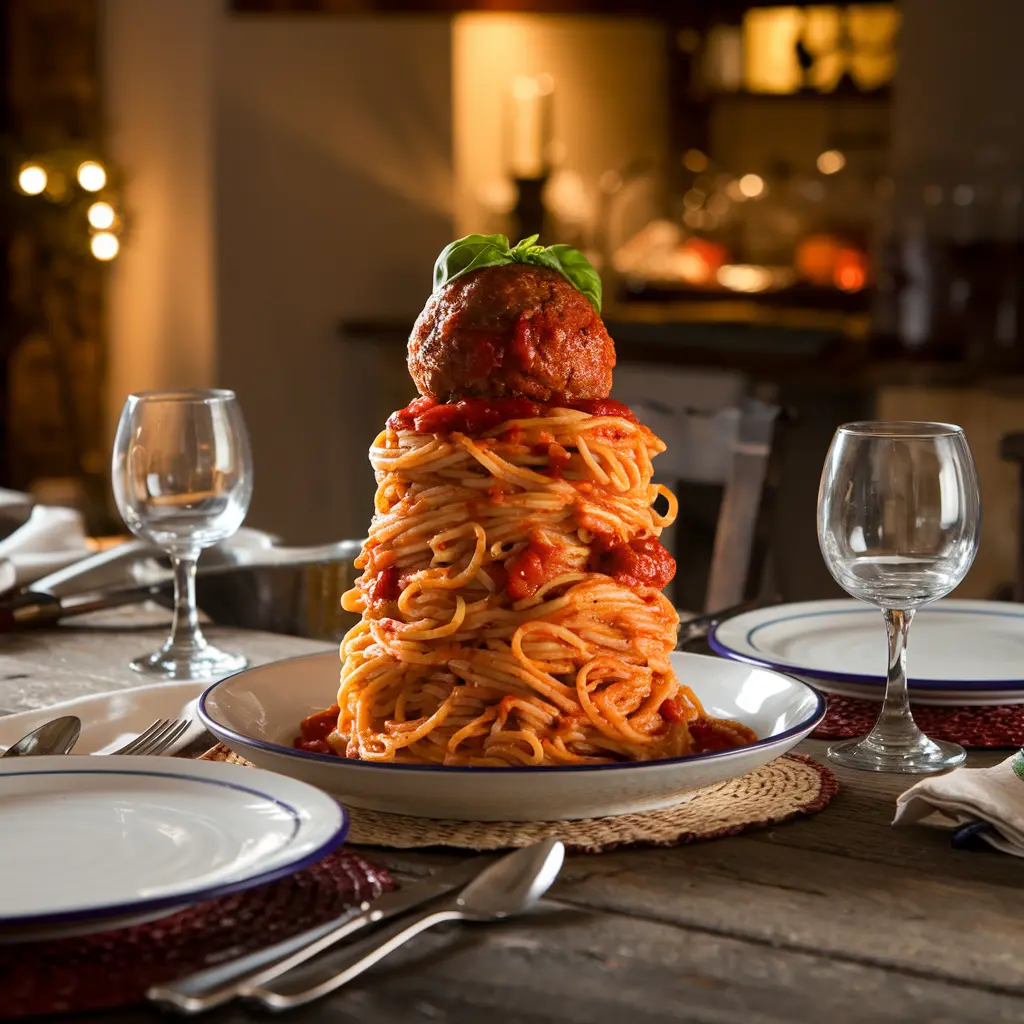Imagine a towering masterpiece of perfectly cooked spaghetti spiraling upward, crowned by a single, enormous, flavorful meatball, drenched in rich tomato sauce. The spaghetti tower with a giant meatball isn’t just a dish—it’s a centerpiece, a conversation starter, and an edible work of art. Whether you’re aiming to impress dinner guests, create a viral food video, or simply indulge in a fun kitchen project, this culinary wonder combines taste and creativity like never before.
This article dives into everything you need to know about creating a spaghetti tower with a giant meatball, from its origins to step-by-step instructions, to tips for perfecting each element. Not only will you learn how to construct this impressive dish, but you’ll also discover its cultural appeal, serving suggestions, and how to avoid common pitfalls.
Ready to start building your edible tower of deliciousness? Let’s begin by exploring the history behind this iconic pairing of spaghetti and meatballs.
Table of Contents
The Origin of Spaghetti Tower
Spaghetti and meatballs may seem like an inseparable duo, but their history is far more nuanced than many realize. While both spaghetti and meatballs are iconic components of Italian-American cuisine, their origins are rooted in distinct culinary traditions that span centuries and continents.
The Italian Roots of Spaghetti
Spaghetti, a type of pasta that originated in Southern Italy, has been a staple in Italian kitchens for centuries. Its earliest ancestors date back to the Roman Empire, where dishes resembling pasta were made from ground grains and water. By the 12th century, dried spaghetti became popular in Sicily due to its convenience and long shelf life, making it a valuable food for travelers and merchants.
What makes spaghetti particularly unique is its ability to pair well with sauces, enhancing flavors and creating a versatile dish. In traditional Italian cuisine, spaghetti is often served with lighter sauces, such as olive oil, garlic, and herbs, rather than the rich tomato-based sauces commonly associated with Italian-American dishes today.
The Meatball Evolution
Meatballs, on the other hand, have a much broader culinary lineage. Variations of meatballs appear in cuisines around the world, from the Swedish köttbullar to the Middle Eastern kofta. The Italian version, known as polpette, is typically smaller than the American meatball and often includes ingredients like breadcrumbs, cheese, garlic, and parsley.
Interestingly, in Italy, meatballs are rarely served with pasta. Instead, they are enjoyed as a standalone dish or as part of a soup. This contrasts with the Italian-American tradition of pairing meatballs with spaghetti, which emerged as immigrants adapted their recipes to new surroundings.
The Italian-American Fusion
The marriage of spaghetti and meatballs was born in the late 19th and early 20th centuries when waves of Italian immigrants arrived in the United States. These immigrants sought to recreate the comforting flavors of their homeland but had to adapt their cooking to the ingredients and economic realities of America.
Tomatoes, which were both affordable and abundant, quickly became a cornerstone of Italian-American cuisine. Furthermore, larger meatballs, often made with a mix of beef, pork, and veal, were introduced as a practical way to create hearty and satisfying meals. Consequently, the result was a rich and flavorful dish that not only symbolized abundance and comfort but also resonated deeply with the immigrant experience.
Over time, spaghetti and meatballs gradually became a beloved staple of American cuisine, frequently celebrated in movies, TV shows, and family dinners across the nation. As a result, this classic pairing evolved into a symbol of comfort and togetherness. Today, it not only represents culinary creativity but also showcases cultural adaptation, ultimately laying the foundation for innovative dishes such as the spaghetti tower with a giant meatball.
Spaghetti Tower Why It Works
The combination of spaghetti and meatballs satisfies multiple sensory cravings: the al dente texture of pasta, the hearty richness of meat, and the tangy-sweet balance of tomato sauce. Together, these elements create a dish that is as comforting as it is versatile, capable of being elevated into a show-stopping presentation like the spaghetti tower.
Now that we’ve explored the roots of this iconic pairing, let’s delve into the creative and culinary possibilities that make the spaghetti tower a must-try dish.
Why Create a Spaghetti Tower?
The spaghetti tower with a giant meatball is not just a meal—it’s a spectacle. This culinary creation brings together the artistry of food presentation and the satisfying flavors of classic comfort food. Whether you’re hosting a special occasion or experimenting with creative cooking, there are plenty of reasons to try building a spaghetti tower.
An Edible Centerpiece
Imagine placing a towering spaghetti creation at the center of your dinner table. The height, structure, and rich red sauce cascading down the sides instantly capture attention and spark conversation. It’s the perfect dish to impress guests, especially at events like birthdays, family gatherings, or holiday dinners.
A spaghetti tower combines food with art, creating a visual masterpiece that tastes as good as it looks. Its bold presentation sets the tone for a memorable meal, showcasing your culinary creativity.
Spaghetti Tower A Viral Food Trend
In the age of social media, food presentation matters more than ever. Unique and whimsical dishes, like the spaghetti tower, often become viral sensations, garnering likes, shares, and comments. Foodies love innovative ideas that push the boundaries of traditional cooking.
The spaghetti tower is particularly photogenic. Its gravity-defying structure and dramatic sauce topping make it ideal for Instagram posts, TikTok videos, or YouTube cooking tutorials. By creating your own spaghetti tower, you can join the growing trend of turning food into entertainment.
A Fun Family Project
Cooking doesn’t have to be a solo endeavor. Building a spaghetti tower can be a delightful project for families, allowing everyone to participate. Kids can help twirl the spaghetti into layers, while adults handle the cooking and assembly of the giant meatball.
This hands-on activity is not only fun but also educational. It teaches basic cooking techniques, teamwork, and even a bit of physics as you figure out how to make the tower stand tall without collapsing.
A New Take on a Spaghetti Tower
Spaghetti and meatballs is a timeless favorite, but sometimes, it’s fun to reinvent the classics. The spaghetti tower adds a touch of drama and creativity to an otherwise familiar meal. It elevates the dish from everyday dinner to a gourmet experience.
Additionally, the tower format introduces new textures and eating experiences. The spiraled spaghetti provides layers of flavor, while the giant meatball offers a rich, meaty centerpiece that everyone will want to dig into.
Ideal for Food Enthusiasts
If you’re someone who loves to experiment in the kitchen, the spaghetti tower is a must-try. It challenges you to think about food in new ways, from stacking techniques to flavor combinations. Plus, it allows you to show off your culinary skills in a way that’s both delicious and awe-inspiring.
Bringing Joy to the Table
At its core, the spaghetti tower with a giant meatball is all about bringing joy. Its whimsical design and hearty flavors create a sense of delight that resonates with people of all ages. Whether it’s the surprise on your guests’ faces or the satisfaction of constructing the tower, this dish is guaranteed to make mealtime special.
Now that you’re inspired to try this creative dish, let’s dive into the ingredients you’ll need to build your own spaghetti tower masterpiece.
Ingredients for the Spaghetti Tower
Creating a spaghetti tower with a giant meatball not only requires a mix of high-quality ingredients for the pasta, sauce, and meatball but also demands careful attention to detail. Each component plays a crucial role in the dish’s taste, texture, and visual appeal. Therefore, it is essential to choose the best ingredients to elevate the final result. Below, you’ll find a detailed list of ingredients, along with practical tips for selecting the most suitable options to achieve culinary perfection.
Ingredients for the Spaghetti
- Spaghetti:
- Quantity: 1 pound (450 grams).
- Tip: Use high-quality durum wheat pasta to ensure it holds its shape and provides the ideal texture for layering.
- Olive Oil:
- Quantity: 2 tablespoons.
- Purpose: Prevents the spaghetti from sticking together during cooking.
- Salt:
- Quantity: 1 tablespoon (for boiling water).
- Purpose: Enhances the flavor of the pasta.
Ingredients for the Sauce
A rich, flavorful tomato sauce is essential for coating the spaghetti and draping over the giant meatball. Here’s what you’ll need:
- Canned Crushed Tomatoes:
- Quantity: 28 ounces (800 grams).
- Tip: Look for San Marzano tomatoes for their sweet, tangy flavor.
- Garlic:
- Quantity: 4 cloves, minced.
- Onion:
- Quantity: 1 medium onion, finely chopped.
- Olive Oil:
- Quantity: 3 tablespoons.
- Tomato Paste:
- Quantity: 2 tablespoons.
- Purpose: Adds depth and richness to the sauce.
- Dried Oregano and Basil:
- Quantity: 1 teaspoon each.
- Sugar:
- Quantity: 1 teaspoon.
- Purpose: Balances the acidity of the tomatoes.
- Salt and Pepper:
- To taste.
- Red Pepper Flakes (Optional):
- Quantity: 1/2 teaspoon.
- Purpose: Adds a slight kick of heat to the sauce.
Ingredients for the Giant Meatball -Spaghetti Tower-
The giant meatball serves as the crowning glory of the spaghetti tower. It needs to be flavorful, tender, and structurally sound.
- Ground Meat:
- Quantity: 1 pound (450 grams).
- Tip: Use a mix of beef and pork for the best flavor and texture.
- Breadcrumbs:
- Quantity: 1/2 cup.
- Purpose: Helps bind the meatball and absorb moisture for a tender texture.
- Parmesan Cheese:
- Quantity: 1/4 cup, grated.
- Purpose: Adds richness and umami flavor.
- Egg:
- Quantity: 1 large.
- Purpose: Acts as a binder to hold the meatball together.
- Garlic and Onion:
- Quantity: 2 cloves garlic (minced) and 2 tablespoons onion (finely diced).
- Parsley:
- Quantity: 2 tablespoons, finely chopped.
- Salt and Pepper:
- To taste.
- Milk:
- Quantity: 2 tablespoons.
- Purpose: Keeps the meatball moist and tender.
Optional Ingredients for Garnish
- Fresh Basil Leaves: Adds a touch of freshness and visual appeal.
- Parmesan Cheese (Shredded): Sprinkled over the top for extra flavor.
- Parsley: Chopped and used as a garnish around the base of the tower.
Kitchen Tools You’ll Need
In addition to the ingredients, make sure you have these tools handy:
- Large Pot: For boiling the spaghetti.
- Mixing Bowls: For preparing the meatball and sauce.
- Ovenproof Skillet or Baking Dish: For cooking the meatball.
- Tongs: To layer and twirl the spaghetti.
- Piping Bag (Optional): For a cleaner presentation when assembling the spaghetti tower.
Now that you have your ingredients and tools ready, it’s time to learn how to bring it all together. In the next section, we’ll walk you through the step-by-step process of building your spaghetti tower with a giant meatball.
Step-by-Step Guide to Building the Spaghetti Tower
Constructing a spaghetti tower with a giant meatball requires precision, patience, and a touch of creativity. Follow this detailed guide to prepare each component and assemble your masterpiece.
Preparing the Spaghetti
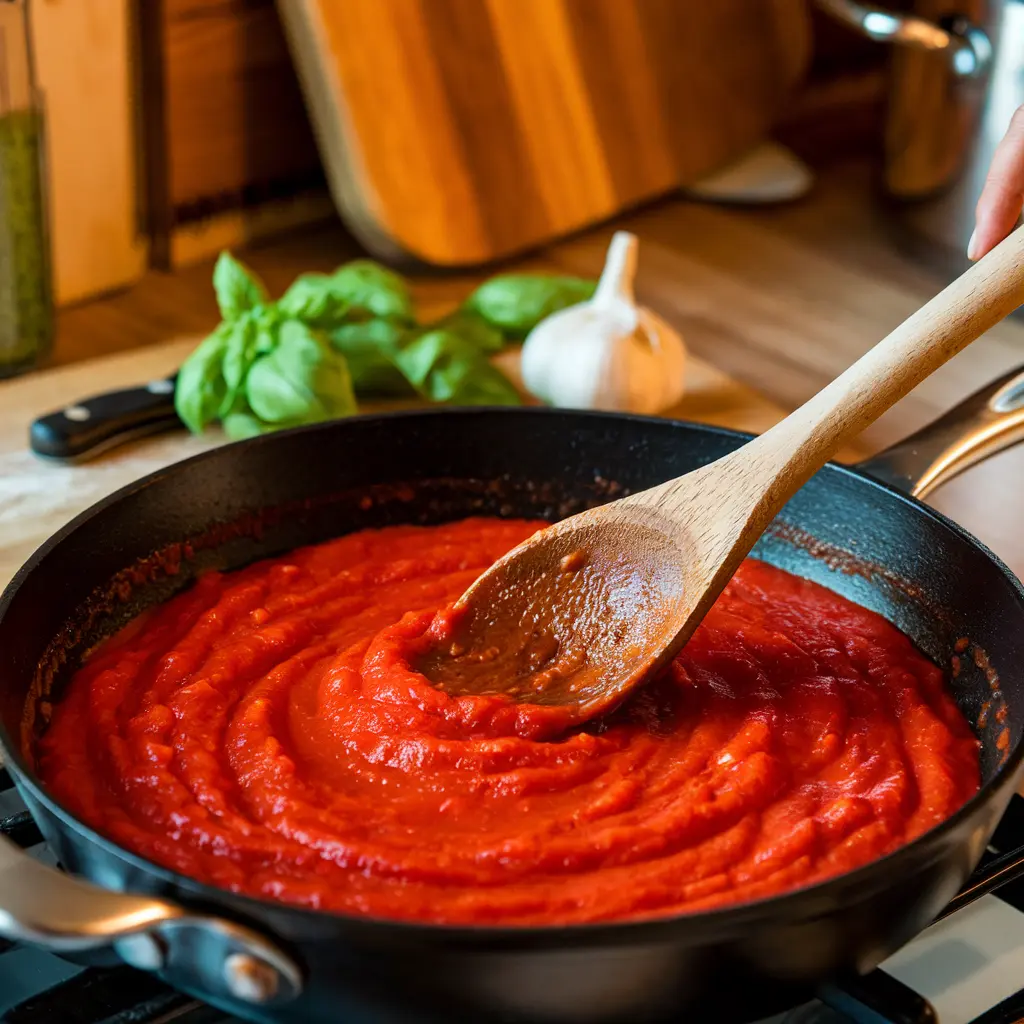
- Boil the Water:
- Fill a large pot with water, add 1 tablespoon of salt, and bring it to a rolling boil.
- Tip: Salting the water enhances the flavor of the spaghetti.
- Cook the Spaghetti:
- Add the spaghetti to the boiling water and cook until al dente (usually 1-2 minutes less than the package instructions).
- Drain the spaghetti and toss it lightly with 2 tablespoons of olive oil to prevent sticking.
- Cool the Spaghetti:
- Spread the spaghetti out on a baking sheet to cool slightly. This will make it easier to handle during assembly.
Making the Sauce
- Sauté the Aromatics:
- Heat 3 tablespoons of olive oil in a large skillet over medium heat.
- Add the chopped onion and garlic, sautéing until softened and fragrant.
- Add the Tomato Base:
- Stir in the tomato paste and cook for 1 minute to enhance its flavor.
- Add the canned crushed tomatoes, oregano, basil, sugar, salt, and pepper.
- Simmer the Sauce:
- Reduce the heat and let the sauce simmer for 20-25 minutes, stirring occasionally.
- Tip: If the sauce becomes too thick, add a splash of water or chicken stock to adjust the consistency.
- Taste and Adjust:
- Add more salt, pepper, or sugar as needed to balance the flavors.
Preparing the Giant Meatball
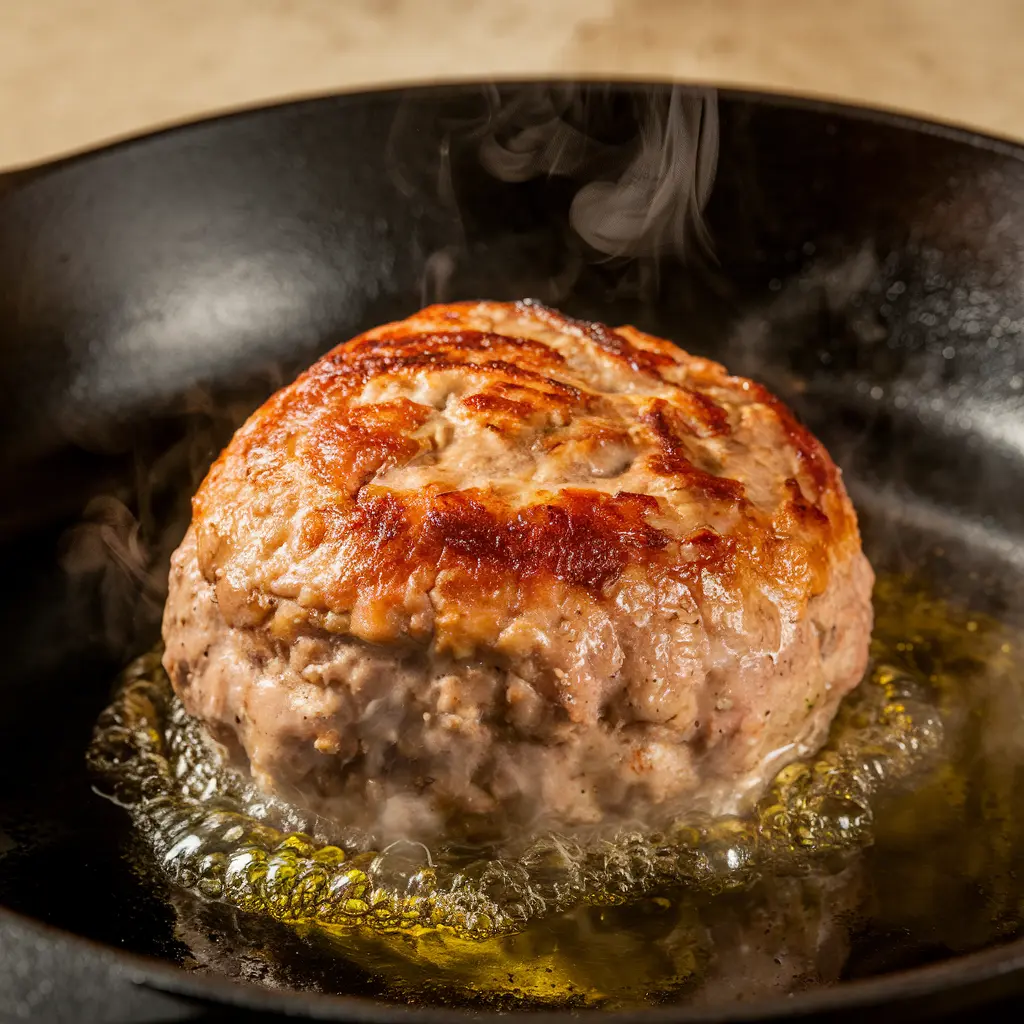
- Mix the Ingredients:
- In a large mixing bowl, combine ground meat, breadcrumbs, Parmesan, egg, milk, garlic, onion, parsley, salt, and pepper.
- Use your hands to mix gently until all the ingredients are evenly incorporated.
- Shape the Meatball:
- Form the mixture into a single, large meatball. It should be compact but not overworked, as this can make it dense.
- Cook the Meatball:
- Preheat your oven to 375°F (190°C).
- Heat a small amount of olive oil in an ovenproof skillet and sear the meatball on all sides until browned.
- Transfer the skillet to the oven and bake the meatball for 25-30 minutes, or until the internal temperature reaches 160°F (71°C).
- Rest the Meatball:
- Remove the meatball from the oven and let it rest for 5 minutes.
How to Assemble the Ultimate Spaghetti Tower
- Prepare the Base:
- Place a small dollop of sauce on your serving plate or platter to anchor the tower.
- Layer the Spaghetti:
- Using tongs or your hands, start by taking small portions of spaghetti and gently twirling them into tight spirals. Then, proceed to stack the spirals one on top of the other, steadily building upward to form a tower shape. Additionally, for extra stability, you can insert a wooden skewer in the center, which will help keep the layers secure as you continue assembling your spaghetti tower.
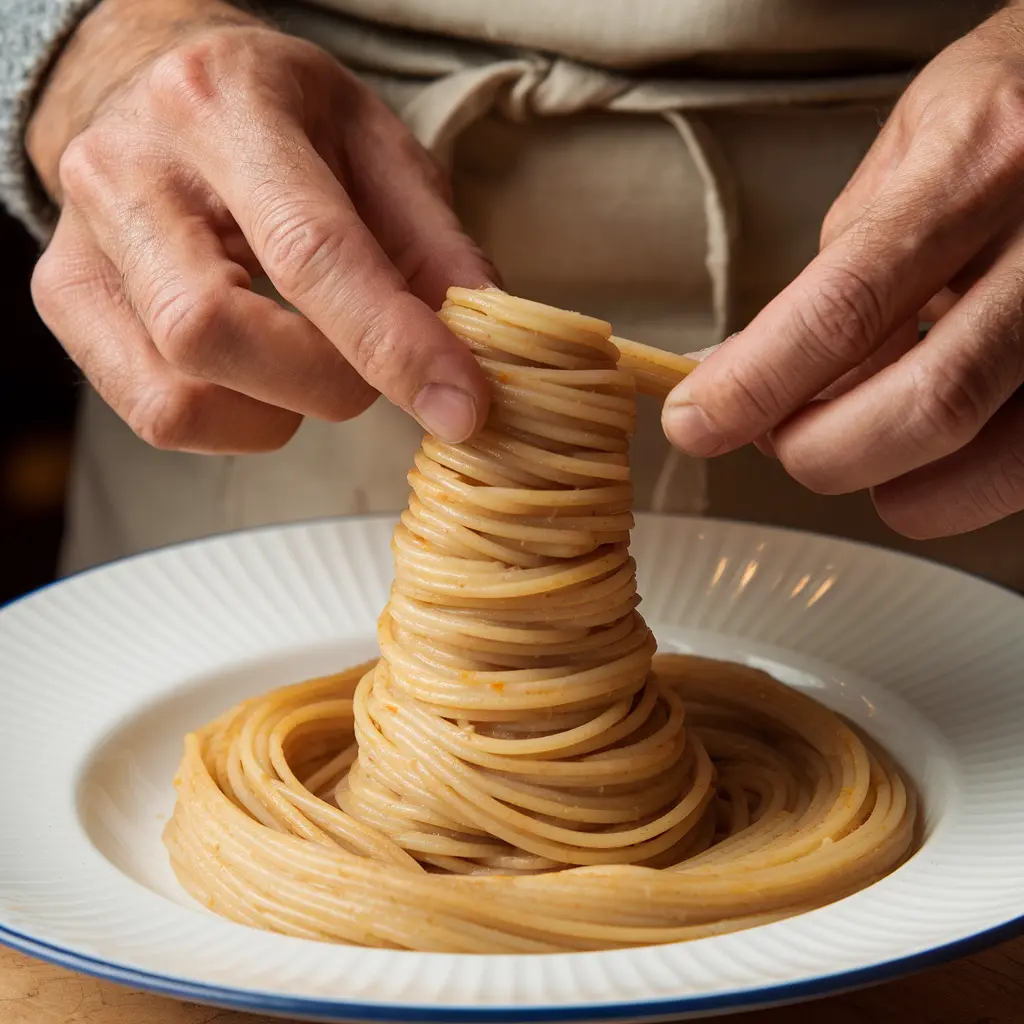
- Top with the Meatball:
- Carefully place the giant meatball on top of the spaghetti tower.
- Remove the skewer if used, being cautious not to disturb the tower’s structure.
- Drizzle with Sauce:
- Spoon the tomato sauce generously over the tower, allowing it to cascade down the sides.
Final Touches
- Garnish:
- Add fresh basil leaves, a sprinkle of Parmesan cheese, and a touch of parsley for a vibrant finish.
- Serve:
- Present the spaghetti tower immediately to your guests for the best visual impact.
- Provide a sharp knife and serving utensils for slicing through the meatball and serving the spaghetti.
With your spaghetti tower assembled, you’re ready to wow your family and friends. In the next section, we’ll explore pairing suggestions and tips for presenting this culinary showpiece in style.
Pairing Suggestions for the Spaghetti Tower
The spaghetti tower with a giant meatball is a bold and flavorful dish that pairs beautifully with complementary sides, drinks, and desserts. These additions not only round out the meal but also enhance the overall dining experience.
Appetizers and Starters
- Garlic Bread:
- Warm, crusty garlic bread is a classic companion to spaghetti dishes. Its buttery, garlicky flavor balances the richness of the sauce and meatball.
- Caprese Salad:
- Slices of fresh mozzarella, ripe tomatoes, and basil drizzled with olive oil and balsamic glaze add a refreshing, tangy contrast to the hearty main dish.
- Bruschetta:
- Toasted baguette slices topped with a mix of diced tomatoes, garlic, and basil make a light and flavorful starter.
Side Dishes
- Roasted Vegetables:
- Seasonal vegetables such as zucchini, bell peppers, and eggplant roasted with olive oil and herbs bring earthy flavors to the table.
- Caesar Salad:
- Crisp romaine lettuce, creamy dressing, and crunchy croutons offer a cool, tangy complement to the warm, savory tower.
- Polenta Fries:
- These crispy, golden fries made from polenta are a unique and satisfying alternative to traditional sides.
Beverages
- Red Wine:
- A medium-bodied red wine like Chianti or Sangiovese pairs excellently with the tomato sauce and meatball.
- Sparkling Water with Lemon:
- For a non-alcoholic option, sparkling water with a slice of lemon cleanses the palate between bites.
- Iced Tea or Lemonade:
- Light, refreshing drinks that pair well with the dish’s rich flavors.
Desserts
- Tiramisu:
- This classic Italian dessert provides a creamy, coffee-infused ending to the meal.
- Panna Cotta:
- A smooth and silky dessert served with berry compote or caramel sauce complements the richness of the main course.
- Gelato:
- Choose flavors like vanilla, pistachio, or hazelnut for a refreshing and satisfying finish.
Serving and Presentation
The way you present the spaghetti tower can not only enhance its appeal as a delicious meal but also transform it into a stunning centerpiece. To achieve this, here are some practical tips that will ensure your dish truly dazzles your guests and leaves a lasting impression.
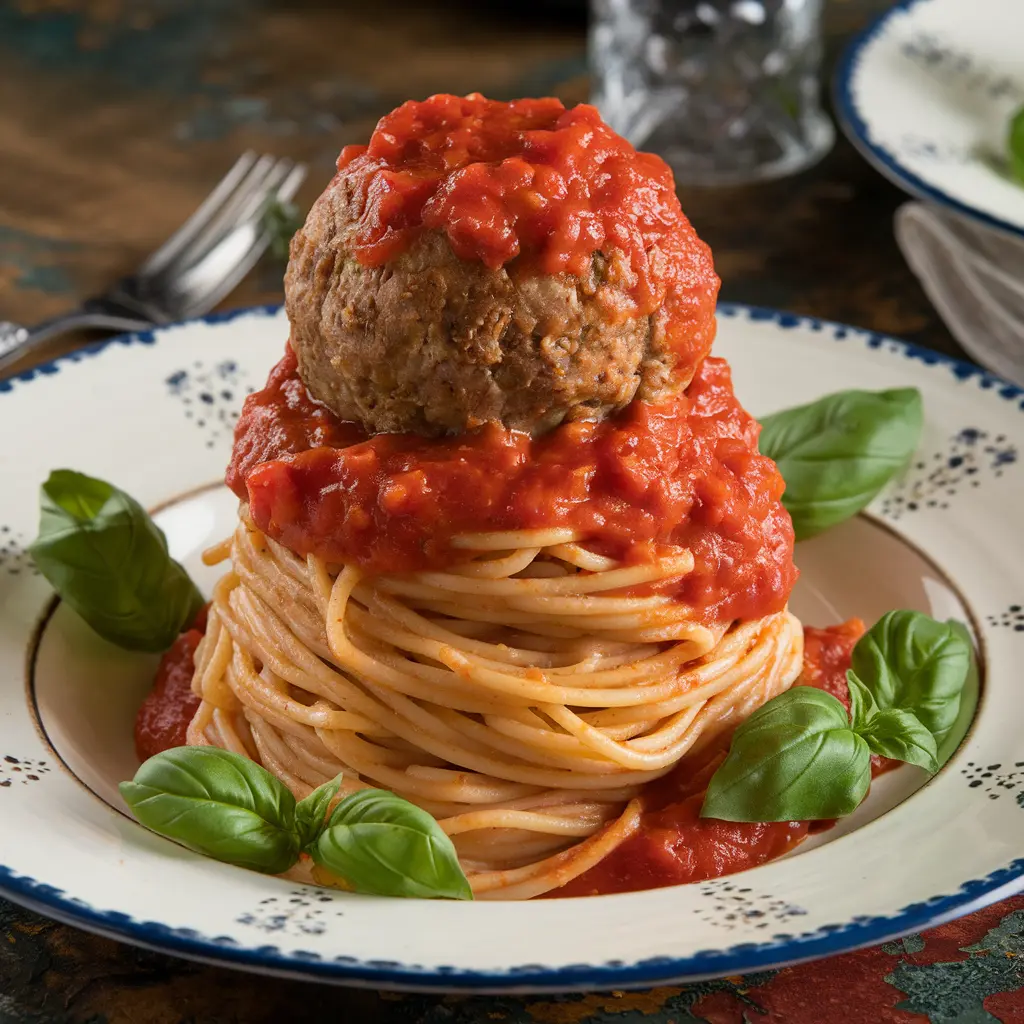
Plate Selection
- Choose a Large Plate or Platter:
- Ensure the plate is wide enough to accommodate the tower without risking collapse.
- White or Neutral Tones:
- A plain background highlights the vibrant red sauce, golden pasta, and green garnishes.
Styling the Spaghetti Tower
- Sauce Placement:
- Drizzle the sauce artfully over the top, allowing it to cascade naturally down the sides of the spaghetti.
- Garnishes:
- Arrange fresh basil leaves and parsley around the base of the tower for added color and freshness.
- Lighting:
- When presenting the dish, use warm lighting to enhance the visual appeal of the glossy sauce and golden spaghetti.
Serving Tips
- Slicing the Meatball:
- Use a sharp knife to slice the giant meatball into portions. Offer each guest a combination of meatball, sauce, and spaghetti for a balanced serving.
- Interactive Eating:
- Encourage guests to pull apart the spirals of spaghetti themselves for a fun, hands-on dining experience.
- Keep it Warm:
- Serve the dish immediately after assembly to ensure all components are warm and fresh.
Why the Spaghetti Tower Is a Crowd-Pleaser
The spaghetti tower with a giant meatball combines drama, flavor, and fun, making it the ultimate centerpiece for gatherings. Its creative presentation draws attention, while the familiar flavors of spaghetti and meatballs ensure universal appeal. It’s a dish that satisfies both the eyes and the palate, turning any meal into a memorable occasion.
FAQs
Can the Spaghetti Tower Be Made Ahead of Time?
Yes, you can prepare the spaghetti, sauce, and meatball in advance. Store them separately in airtight containers and assemble the tower just before serving to maintain freshness and stability.
How Do I Store Leftovers?
Store leftover spaghetti and meatball in separate containers in the refrigerator for up to three days. Reheat in the oven or on the stovetop for the best results.
Can I Use a Vegetarian Option for the Meatball?
Absolutely! You can replace the meatball with a plant-based alternative or a large, breaded eggplant slice for a vegetarian-friendly dish.
What’s the Best Way to Stabilize the Tower?
Using a skewer or dowel during assembly can help keep the layers of spaghetti in place. Remove it carefully before serving.
Can Gluten-Free Pasta Be Used?
Yes, gluten-free spaghetti works well for this dish. Be mindful of the cooking time, as gluten-free pasta tends to be more delicate.
What Size Should the Meatball Be?
The meatball should be roughly the size of a baseball to ensure it’s both visually impressive and easy to cook through.
Conclusion
Building a spaghetti tower with a giant meatball is more than just cooking—it’s an opportunity to showcase your creativity and culinary skills. This dish is sure to leave a lasting impression, whether served at a family gathering, a dinner party, or simply as a fun weekend project. With its stunning presentation and classic flavors, the spaghetti tower is a delicious way to turn a traditional recipe into something extraordinary.

